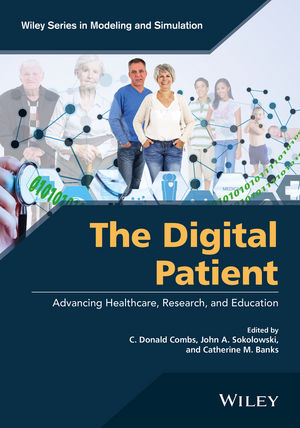
The Digital Patient
John Wiley & Sons Inc (Verlag)
978-1-118-95275-7 (ISBN)
- Titel z.Zt. nicht lieferbar
- Versandkostenfrei innerhalb Deutschlands
- Auch auf Rechnung
- Verfügbarkeit in der Filiale vor Ort prüfen
- Artikel merken
A modern guide to computational models and constructive simulation for personalized patient care using the Digital Patient
The healthcare industry’s emphasis is shifting from merely reacting to disease to preventing disease and promoting wellness. Addressing one of the more hopeful Big Data undertakings, The Digital Patient: Advancing Healthcare, Research, and Education presents a timely resource on the construction and deployment of the Digital Patient and its effects on healthcare, research, and education. The Digital Patient will not be constructed based solely on new information from all the “omics” fields; it also includes systems analysis, Big Data, and the various efforts to model the human physiome and represent it virtually. The Digital Patient will be realized through the purposeful collaboration of patients as well as scientific, clinical, and policy researchers.
The Digital Patient: Advancing Healthcare, Research, and Education addresses the international research efforts that are leading to the development of the Digital Patient, the wealth of ongoing research in systems biology and multiscale simulation, and the imminent applications within the domain of personalized healthcare. Chapter coverage includes:
The visible human
The physiological human
The virtual human
Research in systems biology
Multi-scale modeling
Personalized medicine
Self-quantification
Visualization
Computational modeling
Interdisciplinary collaboration
The Digital Patient: Advancing Healthcare, Research, and Education is a useful reference for simulation professionals such as clinicians, medical directors, managers, simulation technologists, faculty members, and educators involved in research and development in the life sciences, physical sciences, and engineering. The book is also an ideal supplement for graduate-level courses related to human modeling, simulation, and visualization.
C. Donald Combs, PhD, is Vice President and Dean of the School of Health Professions at Eastern Virginia Medical School and is also a senior faculty member in the Department of Modeling, Simulation, and Visualization Engineering at Old Dominion University. John A. Sokolowski, PhD, is Associate Professor and Executive Director of the Virginia Modeling, Analysis, and Simulation Center at Old Dominion University. Catherine M. Banks, PhD, is Research Associate Professor at the Virginia Modeling, Analysis, and Simulation Center at Old Dominion University.
List of Contributors xiii Preface xvii
Part 1 The Vision: The Digital Patient—Improving Research, Development, Education, and Healthcare Practice 1
1 The Digital Patient 3
C. Donald Combs
Health, The Goal, 4
Personalized Medicine, 4
The Best Outcomes, 5
The Emergence of the Digital Patient, 5
The Human Physiome, 6
Enabling the Digital Patient, 8
P4 Medicine, 11
Conclusion, 11
References, 12
2 Reflecting on Discipulus and Remaining Challenges 15
Vanessa Díaz]Zuccarini, Mona Alimohammadi, and César Pichardo]Almarza
Introduction, 15
A Brief Contextual Background and a Call for Integration: Personalized Medicine is Holistic, 16
The Many Versions of the Digital Patient: On the Road to Medical Avatars, 18
Discipulus: The Digital Patient Technological Challenges and Main Conclusions, 19
The Remaining Challenges and Big Data, 24
Conclusion, 25
References, 26
3 Advancing the Digital Patient 27
Catherine M. Banks
Introduction, 27
The Digital Patient: Its Early Start, 28
Engaging the Digital Patient, 30
Conclusion, 31
4 The Significance of Modeling and Visualization 33
John A. Sokolowski and Hector M. Garcia
Introduction, 33
Modeling a Complex System: Human Physiology, 34
Medical Modeling, Simulation, and Visualization, 35
Modes and Types of Visualization, 40
Visualization for Patient]Specific Usefulness, 43
Conclusion, 43
References, 45
Part 2 State of the Art: Systems Biology, the Physiome and Personalized Health 49
5 The Visible Human: A Graphical Interface for Holistic Modeling and Simulation 51
Victor M. Spitzer
Introduction, 51
Education, 53
Modeling, 55
Virtual Reality Trainers and Simulators, 56
Conclusion, 58
References, 59
6 The Quantifiable Self: Petabyte by Petabyte 63
C. Donald Combs and Scarlett R. Barham
Introduction, 63
Smarr’s Quantified Self, 64
Extending Smarr’s Research, 67
The Quantified Self]Vision, Simplified, 69
Criticism, 69
Conclusion, 71
References, 72
7 Systems Biology and Health Systems Complexity: Implications for the Digital Patient 73
C. Donald Combs, Scarlett R. Barham, and Peter M. A. Sloot
Introduction, 73
Systems Biology, 75
The Institute for Systems Biology, 76
The Complexity Institute, 78
The Potential of Systems Biology, 81
Criticism, 82
Conclusion, 83
References, 83
8 Personalized Computational Modeling for the Treatment of Cardiac Arrhythmias 85
Seth H. Weinberg
Introduction, 85
Basics of Cardiac Electrophysiology, 86
Cardiac Modeling Advancements, 89
Regulation of Intracellular Calcium, 90
From Cells to Cables to Sheets to Tissue to the Heart, 91
Where Can we go from Here? What is the Cardiac Model in the Digital Patient? 95
References, 96
9 The Physiome Project, openEHR Archetypes, and the Digital Patient 101
David P. Nickerson, Koray Atalag, Bernard de Bono, and Peter J. Hunter
Introduction, 101
Multiscale Physiological Processes, 102
Physiome Project Standards, Repositories, and Tools, 103
Archetype Specialization, 112
Archetype Definition Language, 113
Linking Archetypes to External Knowledge Sources (Terminology and Biomedical Ontologies), 114
Archetype Annotations, 114
OpenEHR Model Repository and Governance, 115
Fast Healthcare Interoperability Resources, 115
A Disease Scenario, 116
Summary and Conclusions, 121
References, 122
10 Physics]Based Modeling for the Physiome 127
William A. Pruett and Robert L. Hester
Introduction, 127
Modeling Schemes, 128
Future Challenges, 142
Conclusion, 142
Acknowledgments, 143
References, 143
11 Modeling and Understanding the Human Body with SwarmScript 149
Sebastian von Mammen, Stefan Schellmoser, Christian Jacob, and Jörg Hähner
Introduction, 149
Related Work, 150
Multiagent Organization, 152
Designing Interactive Agents, 152
Speaking SwarmScript, 153
Answering Demand: The Design of SwarmScript, 153
Graph]Based Rule Representation, 153
The Source–Action–Target, 154
SwarmScript INTO3D, 154
A SwarmScript Dialogue, 155
Discussion, 159
Summary, 161
References, 162
12 Using Avatars and Agents to Promote Real]World Health Behavior Changes 167
Sun Joo (Grace) Ahn
Introduction, 167
Avatars and Agents, 168
Using Agents and Avatars to Promote Health Behavior Changes, 169
Conclusion, 174
References, 174
13 Virtual Reality and Eating, Diabetes, and Obesity 179
Jessica E. Cornick and Jim Blascovich
Introduction, 179
Virtual Reality, 179
Obesity and Weight Stigma, 184
Virtual Reality as a Tool for Combatting Health Issues, 185
Conclusion, 189
References, 189
14 Immersive Virtual Reality to Model Physical: Social Interaction and Self]Representation 197
Eric B. Bauman
Introduction, 197
Theory for Immersive Virtual Learning Spaces, 197
Conclusion, 202
References, 203
Part 3 Challenges: Assimilating the Comprehensive Digital Patient 205
15 A Roadmap for Building a Digital Patient System 207
Saikou Y. Diallo and Christopher J. Lynch
Introduction, 207
Approach, 210
Building the Digital Patient Through Interoperability, 211
Conclusion, 221
Acknowledgments, 221
References, 221
16 Multidisciplinary, Interdisciplinary, and Transdisciplinary Research: Contextualization and Reliability of the Composite 225
Andreas Tolk
Introduction, 225
Interdisciplinarity and Interdisciplinary Research, 226
Data Engineering to Support Interdisciplinarity and Interoperability, 228
Base Object Models to Support Transdisciplinarity and Composability, 233
Open Challenges on Reliability, 235
Summary and Conclusion, 237
References, 239
17 Bayes Net Modeling: The Means to Craft the Digital Patient 241
Joseph A. Tatman and Barry C. Ezell
Introduction, 241
Other Interesting Applications, 246
Conclusion, 251
References, 253
Part 4 Potential Impact: Engaging The Digital Patient 255
18 Virtual Reality Standardized Patients for Clinical Training 257
Albert Rizzo and Thomas Talbot
Introduction, 257
The Rationale for Virtual Standardized Patients, 258
Conversational Virtual Human Agents, 259
Usc Efforts to Create Virtual Standardized Patients, 260
Conclusion, 269
References, 270
19 The Digital Patient: Changing the Paradigm of Healthcare and Impacting Medical Research and Education 273
V. Andrea Parodi
Introduction, 273
Overview Digital Medicine Projects, 275
Personalized Patient Care Clinical Use, 279
Recommended Education and Training for VPH Project Participation, 281
From Flexner to the 2010 Carnegie Report, 284
Summary Statements, 286
References, 287
20 The Digital Patient: A Vision for Revolutionizing the Electronic Medical Record and Future Healthcare 289
Richard M. Satava
Introduction, 289
Applications of the Digital Patient as the EMR, 291
Discussion, 296
Conclusion, 297
References, 297
21 Realizing the Digital Patient 299
C. Donald Combs and John A. Sokolowski
Index 305
| Erscheint lt. Verlag | 16.2.2016 |
|---|---|
| Reihe/Serie | Wiley Series in Modeling and Simulation |
| Verlagsort | New York |
| Sprache | englisch |
| Maße | 178 x 254 mm |
| Gewicht | 562 g |
| Themenwelt | Mathematik / Informatik ► Informatik ► Theorie / Studium |
| Mathematik / Informatik ► Mathematik | |
| Medizin / Pharmazie ► Medizinische Fachgebiete | |
| ISBN-10 | 1-118-95275-8 / 1118952758 |
| ISBN-13 | 978-1-118-95275-7 / 9781118952757 |
| Zustand | Neuware |
| Informationen gemäß Produktsicherheitsverordnung (GPSR) | |
| Haben Sie eine Frage zum Produkt? |
aus dem Bereich


